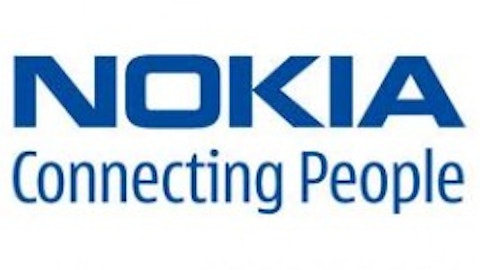Reports have long suggested Amazon.com, Inc. (NASDAQ:AMZN) is working on a Kindle smartphone. The company has slowly made some moves recently that added fire to the rumors. And while we’re short on any physical details of what a Kindle phone might look like, I don’t think its success relies on the phones specs. There are three reasons why the Kindle phone will be successful – a proven business model, the changing wireless market, and Amazon’s retail position.
A proven business model

Unlike Apple’s robust marketing budget, Xiaomi has no marketing budget at all. Yet, batches of 300,000 phones, which the company sells directly through its website, consistently sell-out within minutes.
So how has the company grown so fast? It sells its phones at cost, and makes a profit on services and accessories. Sound familiar?
Its phones compete directly with Apple Inc. (NASDAQ:AAPL)’s and Samsung’s in China – where phones are often sold unsubsidized by wireless carriers. In fact, Xiaomi’s flagship phone the MI-2S has the same processor as the Galaxy S4, and better performance than many of the most popular phones. Customers flock to buy the phones because they’re half the price as Samsung’s or Apple’s.
While Xiaomi plans to expand globally, it’s unclear yet how successful the business will be in markets where phones are often subsidized. Subsidies could completely negate the cost of Xiaomi’s high-end phones, but also provide a more level playing field. There’s a bigger monetary and psychological when comparing $0 to $200 versus $370 and $650.
But who says the Kindle phone needs to roll out in subsidized markets first? Just because the company is based in the U.S. doesn’t mean it can’t target emerging markets where phones are often bought unsubsidized. Even so, the wireless market in the United States is shifting, which provides a great opportunity for a low-price high-end smartphone product.
Changing wireless market
T-Mobile made waves earlier this year when it switched its business model to promote no-contract phones. Under the plan, carrier fees don’t subsidize phone prices, so the service is generally less expensive. The phones, on the other hand, can be more expensive, unless you bring your own.
So far, the new model has seen a slow response. The introduction of the iPhone 5 was relatively successful, however, and T-Mobile is aggressively trying to lure customers with its iPhone trade-in program.
I suspect most consumers are waiting for their current contracts with AT&T Inc. (NYSE:T) and Verizon Communications Inc. (NYSE:VZ) to expire before making the switch with their own phones. As T-Mobile aggressively builds out its LTE network, the switch becomes increasingly enticing.
Yet, the switch may never happen for many. It’s foreseeable that AT&T and Verizon might move to a no-contract model as well if they see a significant shift in subscribers. Verizon Communications Inc. (NYSE:VZ) CEO Lowell McAdam said he’ll be watching customer’s reaction to the plan closely, and implementing a similar plan would be “pretty easy.”
AT&T Inc. (NYSE:T) CEO Randall Stephenson hinted earlier this year that he likes the idea of financing the full cost of phones for subscribers. The idea is very similar to an option T-Mobile provides when you buy a phone from them. He also mentioned he would be keeping an eye on the response to T-Mobile’s offer as well.
In fact, the contract model is often a lose-lose business. Subscribers notoriously hate contracts and being locked in, and carriers take an earnings hit when they subsidize phones. Apple Inc. (NASDAQ:AAPL)’s iPhone is reported to have a significant impact on earnings when a new iteration is released.
I believe the end of the 2-year contract is near. That means a business model like Xiaomi’s would likely succeed in the United States, especially if the phones had a recognized brand name behind it like Amazon Kindle.
Amazon.com, Inc. (NASDAQ:AMZN)’s retail position
Amazon.com, Inc. (NASDAQ:AMZN) has used its position as the top online retailer to do to the tablet market what it could do to the smartphone market. Kindle Fire tablets have captured 22% of the U.S. market through Amazon’s marketing, placement on its website, and by pricing the line near-cost. To put that in perspective, capturing 22% of the smartphone market in the U.S. would put Amazon in the same position Samsung is currently in.
Amazon can afford to sell its tablets and future smartphone near-cost because of its dominance in content. Kindle tablets use a forked version of Google Inc (NASDAQ:GOOG)’s Android OS, which essentially turns them into Amazon content buying machines. Amazon has its own Android app store it uses instead of Google Play, and it can leverage its Prime service as it did with the Fire tablets.
Prime offers subscribers access to a growing video library and a free loaned Kindle eBook once a month. While watching video and reading books isn’t as popular on phones as on tablets, there’s still a sizeable audience. 31% of smartphone users watch movies and 15% read books weekly according to Pew Research. (The same survey found that 24% use their smartphone to shop weekly – an activity Amazon.com, Inc. (NASDAQ:AMZN) knows a thing or two about.)
Including a trial of Prime with its phone could lead to further growth in the Prime subscriber base. This strategy led to fantastic growth with the release of the Kindle Fire, as Morningstar estimates between 30% and 40% of trial users converted to full-time subscribers. Fueling growth in Prime membership could subsidize the phone price, as Prime members are extremely profitable for Amazon.
Smart move
While the Kindle smartphone is still just a rumor, I think it’s the next step in the Kindle line for Amazon.com, Inc. (NASDAQ:AMZN). It already released its 8.9” Fire last fall, now it’s time to focus on a smaller form device. The shifting marketplace and its ability to sell services present an opportunity for Amazon to take advantage of with its near-cost business model.
Adam Levy owns shares of Amazon.com. The Motley Fool recommends Amazon.com. The Motley Fool owns shares of Amazon.com.



